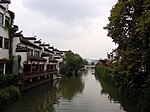Qinhuai River
| Qinhuai River | |
|---|---|
 |
|
| Native name | 秦淮河 |
| Country | China |
| Region | Nanjing, Jiangsu Province |
The Qinhuai River (秦淮河) is a river that runs through central Nanjing. It's also the birthplace of the age-old Nanjing culture. As such, it's called "Nanjing's mother river". It is the "life blood" of the city. The Qinhuai River is divided into inner and outer rivers.
Today, the scenic belt along the Qinhuai River develops with the Confucius Temple at the center and the river serving as a bond. The belt featuring attractions like Zhanyuan Garden, the Confucius Temple, Egret Islet, China Gate as well as the sailing boats in the river and pavilions and towers on the riverbanks is a blend of historic sites, gardens, barges, streets, pavilions, towers and folk culture and customs.
The Qinhuai River, a branch of the mighty Yangtze River has nursed the rich civilization of the region. The inner river of the river once was the red-light district famous throughout the nation in the Ming and Qing dynasties. Painted boats with red lanterns once shuttled to and from, heavily made-up, gifted alms all became historical things. A busy colorful bazaar has gradually taken shape here. Now the flourishing riverside area can be compared to the Nanjing Road of Shanghai and some do call it the "Mini Nanjing Road". Small shops, stores, restaurants and bars cluster the area. One can find everything here ranging from colorful trinkets to local specialties. At night the whole area is lit up with colorful lights thus creating a very impressive scene. A lively street market is set up in the area and both locals and tourists take part in the bargain hunt. Taking a leisurely stroll along the riverside, seeing the Chinese vendors doing their business or boarding colorfully decorated boats on the ancient river could be a memorable experience.
The most prominent part of Qinhuai River Scenic area in history is famous as a residential area of Qin Huai Ba Yan,(秦淮八艳, Eight beauties of Qinhuai River),actually eight beautiful ladies with a lower social status but a great patriotic sense. They were firstly written into a book named Banqiao Zaji(板桥杂记) by Yu Huai(余怀). They respectively were Gu Hengbo(顾横波), Dong Xiaowan(董小宛), Bian Yujing(卞玉京), Li Xiangjun(李香君), Kou Baimen(寇白门), Ma Xianglan(马湘兰), Liu Rushi(柳如是) and Chen Yuanyuan(陈圆圆). Most of them experienced the transition of dynasties and the turmoil of society. They lived in the lowest class of society with the strongest sense of patriotism. They were quite talented in painting and poem composition, but most of their works were lost. Straightforwardly, they were prostitutes and singers, but their heart and spirit were pure absolutely. Their love stories were also romantic and historically influential. In folk china, they were respected widely.
...
Wikipedia
